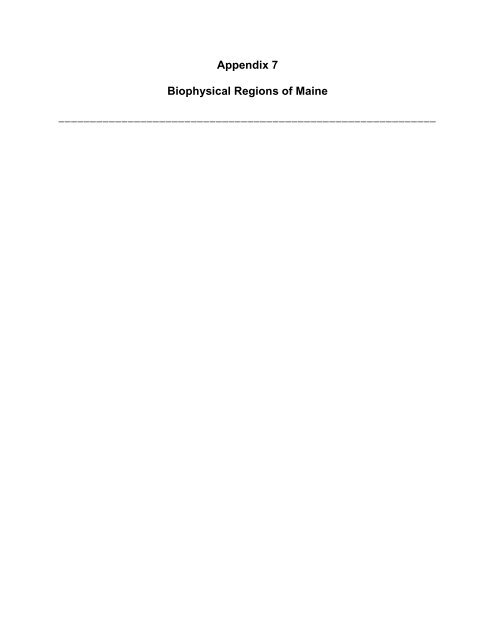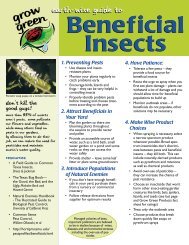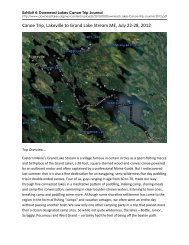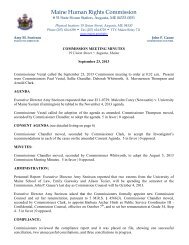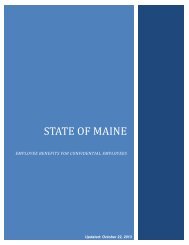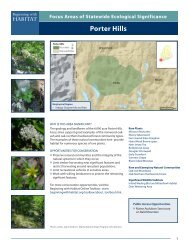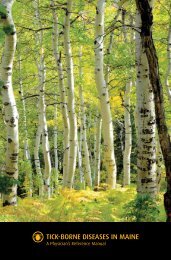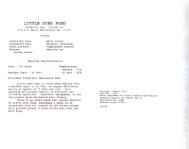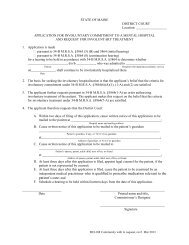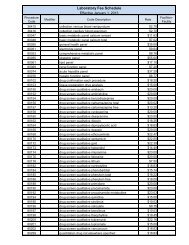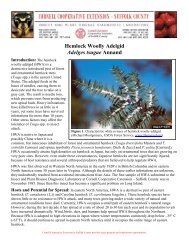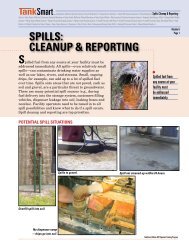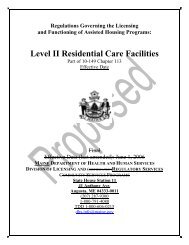BIOPHYSICAL REGIONS - Maine.gov
BIOPHYSICAL REGIONS - Maine.gov
BIOPHYSICAL REGIONS - Maine.gov
Create successful ePaper yourself
Turn your PDF publications into a flip-book with our unique Google optimized e-Paper software.
Appendix 7<br />
Biophysical Regions of <strong>Maine</strong><br />
____________________________________________________________
Appendix 7 Biophysical Regions of <strong>Maine</strong><br />
Biophysical Regions of <strong>Maine</strong><br />
The following description of <strong>Maine</strong>’s 15 biophysical regions is excerpted from The<br />
biophysical regions of <strong>Maine</strong>: Patterns in the landscape and vegetation (McMahon<br />
1990).<br />
Boundary Plateau Region<br />
Physiography: The Boundary Plateau Region extends from the St. Francis River south to<br />
Penobscot Lake along the <strong>Maine</strong>-Quebec border and includes the lands west of the Saint John<br />
River and Boundary Mountains. The region is a relatively flat featureless plateau with few ponds<br />
and lakes. Elevations average between 1000’ and 1200’ except for a cluster of gently rolling hills<br />
in the southern section that rise to elevations of 1600’ or more. The northwestern portion of the<br />
region is underlain by mélange – a sheared, fine-grained pelitic matrix mixed with angular and<br />
poorly sorted inclusions of diverse origins and geologic ages. Bedrock of the southern portion is<br />
dominated by weakly metamorphosed interbedded pelite (mudstone) and sandstone. The<br />
geology of this part of the state has not been mapped in detail.<br />
Climate: Based on climate observations from the first half of the century (there are no weather<br />
stations in the region), the Boundary Plateau experiences the harshest winters in <strong>Maine</strong>. The<br />
frost-free season is approximately 80 days, which is less than half that of south coastal <strong>Maine</strong>.<br />
The April to November heat sum for the northern portion of the region (2100 degree days) is the<br />
lowest in the state. Average annual snowfall ranges from 100” to 110” and average minimum<br />
January temperature is less than 0° F. Average maximum temperature in July is 77° F, which is<br />
comparable to other regions in northern <strong>Maine</strong>. Average minimum July temperature (52° F) is<br />
the lowest in the state.<br />
Surficial Geology and Soils: The Boundary Plateau Region is dominated by the most extensive<br />
stagnation moraine in the state. This moraine, which is composed of thin, course- textured<br />
ablation till, overlies dense basal till and is dissected by scattered outwash deposits, lake bottom<br />
deposits, and stream alluvium. Extensive areas of thin drift surround the moraine. This parent<br />
material, which is derived from fine-grained shales, slates, and phyllites, has given rise to very<br />
deep loamy soils. In the northern portion of the region, shallow (10”-20”) somewhat excessively<br />
drained Thorndike soils occur on ridges of thin drift, with deeper (> 60”) moderately well drained<br />
Chesuncook soils on midslopes, and somewhat poorly drained Telos soils on lower slopes.<br />
Dense basal till typically underlies the course loamy Monarda and Burnham and the finer Daigle<br />
and Aurelie soils that are characteristic of valleys and broad flat uplands of the region. The<br />
basal till keeps the water table at or near the surface for 7 to 9 months of the year.<br />
Vegetation and Flora: The poorly drained uplands and valleys of the region support large<br />
stands of Picea rubens, Picea mariana, and Abies balsamea. Drier ridges support northern<br />
hardwood species such as Acer saccharum and Betula alleghaniensis. Species richness of<br />
woody plants is low relative to the rest of <strong>Maine</strong>, averaging only 94 species. By comparison,<br />
midcoast <strong>Maine</strong> supports more than 190 species. The Boundary Plateau region also supports<br />
the highest concentration of ribbed fens in the state. A cluster of 14 ribbed fens is located in the<br />
slightly sloping lowland between the Daaquam River and the Southwest Branch of the St. John<br />
River – an area of impeded drainage.<br />
1
Appendix 7 Biophysical Regions of <strong>Maine</strong><br />
Saint John Uplands Region<br />
Physiography: The Saint John Uplands extend from Fort Kent to the Seboomook Lake area<br />
and include the uplands east of the Saint John River as well as those to the east and west of the<br />
Allagash River. The eastern boundary of the region is roughly defined by the 1000’ contour line.<br />
The terrain consists of rolling uplands dissected by broad valleys. Large lakes dominate the<br />
southern portion of the region. Elevations range from 800’ in the valleys to 1000’ to 2000’ in<br />
upland areas. Several peaks rise above 2000’ including Peaked Mountain (2270’), Round<br />
Mountain (2147’), Little Russell Mountain (2376’), Seboomook Mountain (2390’), and Green<br />
Mountain (2395’).<br />
The northern portion of the region is composed almost entirely of weakly metamorphosed<br />
pelites and sandstones except for a small pluton of syenite and monzodiorite in the Deboullie<br />
area. The bedrock geology is more complex to the south where intrusive rocks (primarily<br />
andesite and basalt) and mélange occur. An unusual landform of the region are the coneshaped<br />
mountains that dot the landscape where bedrock is of igneous origin.<br />
Climate: The climate of the region is characterized by cold winter temperatures, low annual<br />
precipitation, and a short frost-free season. Average maximum July temperatures vary from 75°<br />
F in St. Francis to 77° F in Clayton Lake. Average annual precipitation (34”) is the lowest in the<br />
state. A frost-free season of 80 to 100 days and a heat sum of 2300 degree days are<br />
comparable to that of the Boundary Plateau.<br />
Surficial Geology and Soils: The rolling terrain of the region is covered by thin drift. Bedrock is<br />
at or near the surface except in the valleys where stagnation moraine tills, glaciofluvial deposits,<br />
and stream alluviums are present. In the northern portion of the region, however, dark gray,<br />
fine-grained shales and slates have given rise to deep, coarse, loamy soils. Soils in upland<br />
areas are generally shallow (10”-20”) well-drained Thorndike and deep (20”-40”) moderately<br />
drained Winnecook soils on ridge tops, with well to moderately well drained Elliottsville and<br />
Chesuncook soils on the midslopes. Very deep (> 60”) somewhat poorly drained Telos and<br />
Daigle soils occur at lower elevations. In central and southern sections, where the terrain is<br />
flatter, deep, and somewhat poorly drained, Telos, Monarda, and Burnham soils are typical.<br />
Lyman, other similar skeletal soils, and soils of the Marlow catena are associated with the steep<br />
cone-shaped hills in this portion of the region.<br />
Vegetation and Flora: Like the Boundary Plateau, the Saint John Uplands Region has a<br />
depauperate flora compared to other regions of the state. The eastern boundary of the region<br />
coincides with a topographically defined vegetation transition zone where species of boreal<br />
affinity are replaced by species characteristic of temperate regions. Woody species that are<br />
uncommon or nonexistent west of this transition zone include Acer saccharinum, Amelanchier<br />
stolonifera, Arctostaphylos uva-ursi, Betula populifolia, Cornus rugosa, Dirca palustris, Fraxinus<br />
americana, Hamamelis virginiana, Ostrya virginiana, Prunus nigra, Quercus rubra, Quercus<br />
macrocarpa, Rhamnus alnifolia, Rhus typhina, Ribes hirtellum, Rosa palustris, Rosa virginiana,<br />
Salix petiolaris, Sambucus canadensis, Tilia americana, and Viburnum lentago. The 1000’<br />
contour also roughly defines the northern and western limit of eccentric bog distribution in<br />
<strong>Maine</strong>.<br />
2
Appendix 7 Biophysical Regions of <strong>Maine</strong><br />
Aroostook Hills Region<br />
Physiography: The Aroostook Hills Region extends from the Saint John River near Madawaska<br />
south to the Patten area. The western boundary is delineated by the 1000’ contour line and the<br />
eastern boundary is defined by the calcareous bedrock and tills that underlie the Aroostook<br />
Lowlands. The region is characterized by gently rolling terrain with elevations averaging<br />
between 800’ and 1000’. Scattered mountains occur in the Winterville area and on a small<br />
pluton north of Shin Pond. Topographic highs include Pennington Mountain (1578’), Green<br />
Mountain (1687’), and Mount Chase (2440’). Unlike the Saint John Uplands and Aroostook<br />
Lowlands, lakes and peatlands are abundant.<br />
Bedrock of the region is almost entirely composed of weakly metamorphosed interbedded<br />
pelites, sandstones, and some limestone. Intrusives include a belt of metavolcanic rock that cuts<br />
across the central portion of the region and the quartz diorite pluton that underlies Mount Chase.<br />
Climate: Except for maximum July temperature, which averages 78° F throughout the region,<br />
climate varies considerably from north to south. Winter temperatures, annual precipitation, and<br />
snowfall are lower in the north. On average, the length of the frost-free season is 20 days<br />
shorter in the central portion of the region than either the north or the south. The average<br />
minimum January temperature ranges from 4° F near Patten to -5° F near Squa Pan. Average<br />
annual precipitation ranges from 43” in Patten to 35” in Squa Pan and average snowfall ranges<br />
from 120” in Patten to 100” in the north. The climate is intermediate between the Saint John<br />
Uplands and the Aroostook Lowlands.<br />
Surficial Geology and Soils: The eastern portion of the region has extensive but scattered<br />
deposits of glaciolacustrine sediments on which cedar swamps and peatlands have developed.<br />
The western portion is covered with thin drift and pockets of deeper till. Shallow (10”-20”)<br />
excessively drained Thorndike silt loams occur on ridge tops, well to moderately well-drained<br />
Plaisted silt loams and Chesuncook loams occur on upper slopes, and finer poorly drained<br />
Aurelie and somewhat poorly drained Daigle soils are typical of valleys in the northern portion of<br />
the region. In the south, shallow course-grained Lyman or fine-grained Monson soils are<br />
characteristic of higher elevations, with somewhat poorly drained Colonel fine sandy loams and<br />
Telos loams below. Deep poorly drained Monarda loams are widespread in the valleys.<br />
Vegetation and Flora: The western boundary of the region coincides with a vegetation transition<br />
zone where species characteristic of temperate regions are replaced by those of more boreal<br />
affinity. In addition to this transition zone, two peatland types, eccentric bogs and concentrically<br />
patterned raised bogs, reach their western limit in <strong>Maine</strong> here. This is apparently a topographic<br />
rather than a climatic limit – the total number and area of peat lands are generally less in<br />
mountainous well-drained terrain. Raised bogs are confined to the limited number of flat basins<br />
that are scattered among the hills and mountains, while eccentric bogs occur on the gentle<br />
slopes rising from these basins. Forest ecosystems are more diverse in the Aroostook Hills<br />
Region than in western portions of Aroostook County.<br />
Aroostook Lowlands Region<br />
Physiography: The Aroostook Lowlands extend from the Saint John River west of Van Buren<br />
south to Linneus. The western boundary coincides with the westward extent of calcareous tills<br />
and bedrock. Elevations are relatively low (approximately 600’ to 800’) except for a few<br />
3
Appendix 7 Biophysical Regions of <strong>Maine</strong><br />
scattered monadnocks (Squa Pan Mountain, Number Nine Mountain and Mars Hill), which rise<br />
above gently rolling terrain. Bedrock consists of weakly metamorphosed interbedded pelite,<br />
limestone, dolomite, and calcareous pelites and sandstones. These represent the most<br />
extensive calcareous formations in the state. Weakly metamorphosed andesite, basalt, and<br />
rhyolite occur in the central portion of the region. Igneous rocks are limited to two small granitic<br />
plutons west of Houlton.<br />
Climate: The climate is relatively uniform throughout the region, with an average maximum July<br />
temperature of 77° F and a mean minimum January temperature of -1° F. While average<br />
precipitation (38”) is higher than in other northern regions, average annual snowfall (100”) is<br />
slightly lower. The frost-free season, which ranges from 95 to 110 days is longer than other<br />
regions in northern <strong>Maine</strong>.<br />
Surficial Geology and Soils: The entire region is covered with till – much of it weakly<br />
calcareous. Two large stagnation moraines occur in northern and central portions. Deep till<br />
deposits contribute to the region’s undulating topography. Bedrock is rarely exposed except for<br />
areas north and south of Mars Hill where numerous ledge outcrops occur. Soils are typically<br />
deep (> 60”) fine loams derived from calcareous dark gray shale, siltstone, phyllite, and<br />
limestone. Well-drained Mapleton and Caribou soils are common on ridges and gentle slopes,<br />
while moderately well-drained soils occur on lower slopes. On the broad flat lowlands of the<br />
northwestern portion of the region, where the till is dense, soils in the Perham, Daigle, and<br />
Aurelie series occur. These areas are generally poorly drained. Scattered glaciofluvial deposits<br />
have given rise to well-drained sandy loams, particularly along the Aroostook River and some of<br />
its tributaries.<br />
Vegetation and Flora: The Aroostook Lowlands support a number of calciphiles that are rare or<br />
do not occur elsewhere in <strong>Maine</strong>, including Allium schoenoprasm, Anemone multifida,<br />
Astragalus alpinus, Carex sterilis, Cypripedium reginae, Drosera linearis, Equisetum<br />
variegatum, Erigeron hyssopifolius, Primula mistassinica, Polygala seneca, Rhyncospora<br />
capillacea, Salix candida, Salix exigua, Spiranthes lucida, Tofieldia glutinosa, Valeriana<br />
uliginosa, and Woodsia alpina.<br />
Two ecosystem types that are well developed in the southern portion of the region include<br />
circumneutral cedar swamps and weakly calcareous fens. Most of these are associated with the<br />
Carys Mills Limestone Formation. A number of woody species reach range limits in the region.<br />
Species reaching southern limits include Crataegus laurentiana, Salix candida, Salix exigua,<br />
and Salix myricoides. Species reaching northern limits include Aralia racemosa, Aronia<br />
arbutifolia, Crataegus macrocantha, Prunus serotina, Quercus macrocarpa, Rubus odoratus,<br />
Ulmus rubra and Vitis riparia. Woody species richness averages 125, which is the highest of<br />
the four northern regions.<br />
Western Mountains Region<br />
Physiography: The Western Mountains Region extends from Boundary Bald Mountain along<br />
the <strong>Maine</strong>-Quebec border to the Mahoosuc Range in southwestern <strong>Maine</strong>. The eastern<br />
boundary is defined by the 1000’ contour line except for the northern portion, which includes<br />
several valleys of lower elevation west of Moosehead Lake. The region includes the Boundary<br />
Mountains to the north and the Longfellow Mountains to the south. These two mountain ranges<br />
are separated by a series of large lakes, including Umbagog, Upper and Lower Richardson,<br />
4
Appendix 7 Biophysical Regions of <strong>Maine</strong><br />
Rangeley, and Flagstaff. The mountainous landscape is highly dissected by small, steep-sided<br />
streams. Elevations average between 1000’ and 2000’.<br />
The bedrock of the region is extremely complex. Dozens of plutons of various ages and<br />
compositions have intruded interbedded pelites and sandstones, which, as a result, are highly<br />
metamorphosed. A large complex of basement rock surrounds Kibby Mountain. Smaller<br />
occurrences of metavolcanic rocks are scattered throughout the region.<br />
Climate: The Western Mountains are characterized by cool summer temperatures, low annual<br />
precipitation, and high snowfall. Average maximum July temperature (75° F) is lower than any<br />
part of the state except the Eastern Coastal Region. Average minimum January temperature (-<br />
1° F) is comparable to that of northern <strong>Maine</strong>. Average annual precipitation is low (39”),<br />
although some of the higher mountains produce a rain shadow effect with precipitation as high<br />
as 50” on windward slopes and less than 35” to leeward. Average annual snowfall is 110”. A<br />
heat sum of 2300 degree days is lower than any region except the Boundary Plateau and the<br />
Saint John Uplands.<br />
Surficial Geology and Soils: At elevations greater than 2500’, soils are cold, acidic, and<br />
generally well drained. Shallow Saddleback soils occur on ridge tops, while deeper Enchanted<br />
soils occur on steep slopes. Both are cryic soils, which are characterized by a mean annual soil<br />
temperature between 32° and 47° F. Average summer soil temperature is less than 60° F if<br />
there is no water table present or less than 55° F if the water table is near the surface. Thin,<br />
freely drained, organic soils are also common at high elevations. These Ricker soils are derived<br />
from organic matter that has accumulated on a very thin mineral horizon. Saddleback and<br />
Enchanted soils are derived from mica schist and phyllite with some granite and gneiss. At<br />
middle and lower elevations, soils are typically deep, somewhat poorly drained Telos, Monarda,<br />
and Colonel coarse loamy soils. Ice-contact glaciofluvial deposits and stream alluvium fill many<br />
of the valleys. Soils derived from these deposits tend to be well to excessively drained gravels,<br />
sands, and sandy loams.<br />
Vegetation and Flora: Stands of Picea rubens and Abies balsamea are common on ridge tops,<br />
and subalpine forest, which is made up almost exclusively of Abies balsamea, occurs at<br />
elevations greater than 2500’. Acer saccharum, Betula alleghaniensis, and Fagus grandifolia<br />
are common in the valleys. On treeless peaks, alpine communities such as dwarf shrub heath,<br />
sedge or rush meadow, fellfield, snowbank, and alpine bog occur. Ribbed fens are believed to<br />
reach their southern extent in North America in the northern part of this region.<br />
Woody species of northern affinity that occur in the Western and Central Mountain Regions<br />
include Betula cordifolia, Empetrum eamesii ssp. atropurpurem, Empetrum nigrum, Rubus<br />
chamaemorus, Salix uva-ursi, Vaccinium boreale (historic), Vaccinium uliginosum ssp.<br />
uliginosum, Vaccinium vitis-idaea, and Viburnum edule. Woody species richness, which<br />
averages 105 species, is low relative to most other regions.<br />
Central Mountains Region<br />
Physiography: The Central Mountains Region includes the Katahdin group and surrounding<br />
foothills. It also includes the highlands surrounding Moosehead Lake. The region contains the<br />
greatest relief in the state with elevations ranging from 600’ to 5268’. Topographic highs include<br />
Baxter Peak (5268’), White Cap (3644’), Baker Mountain (3520’), Traveler (3541’), North Turner<br />
(3323’), South Turner (3122’), and Big Spencer (3230’).<br />
5
Appendix 7 Biophysical Regions of <strong>Maine</strong><br />
Bedrock is dominated by the Katahdin Pluton, which is composed of granite and granodiorite. A<br />
series of smaller plutons composed of gabbro and other ultramafic rocks underlies the Whitecap<br />
Mountain area. Bedrock of the surrounding hills is composed primarily of weakly<br />
metamorphosed pelites and sandstones. Melange and metavolcanic outcrops occur northeast<br />
of Moosehead Lake.<br />
Climate: The climate of the Central Mountains resembles that of the Western Mountain Region<br />
except that summers are slightly milder, winters are slightly colder, and the frost-free season<br />
(approximately 100 days) averages 10 days longer. Mean maximum July temperature is 77° F<br />
and mean minimum January temperature is 1° F. As in the Western Mountains, annual<br />
precipitation is variable because of an orographic effect. Average annual precipitation is 38”,<br />
while average annual snowfall is 120”, the highest in the state.<br />
Surficial Geology and Soils: The most extensive bedrock outcrops in the state occur in this<br />
region. The remaining landscape is covered with thin drift and till with scattered eskers and<br />
glaciofluvial deposits. Some of the deepest deposits occur in the ribbed moraine southeast of<br />
the Katahdin mountains, where coarse-textured Hermon soils predominate. As in the Western<br />
Mountains, the higher peaks are covered with cryic Saddleback and Enchanted soils, although<br />
these are not extensive. Where bedrock is near the surface, fine-textured, somewhat<br />
excessively drained Monson loams have developed. At lower elevations, in till derived from<br />
metasedimentary rocks, well-drained Elliottsville loams occur. Wetter and deeper Telos and<br />
Monarda soils are typical of valleys and flatter areas.<br />
Vegetation and Flora: The Katahdin area is known for its alpine vegetation. Disjunct woody<br />
species that occur here and nowhere else in <strong>Maine</strong> include Arctostaphylos alpina, Betula<br />
glandulosa, Betula minor, Cassiope hypnoides, Loiseleuria procumbens, Phyllodoce caerulea,<br />
Rhododendron lapponicum, Salix arctophila, Salix argyrocarpa, and Salix herbacea. Woody<br />
species richness is high (132 species) on Mount Katahdin relative to the surrounding area.<br />
As in the Western Mountains, the region is dominated by spruce-fir forests in poorly-drained<br />
valleys and on ridges, and northern hardwoods at middle elevations. Extensive stands of<br />
subalpine forest occur between the krummholtz zone and the 2500’ contour.<br />
Western Foothills Region<br />
Physiography: The Western Foothills parallel the Western and Central Highlands in a 10 to 20<br />
mile wide band. Elevations in the region average between 600’ and 1000’. The terrain is hilly.<br />
The entire region is underlain by metasedimentary rocks except for several small plutons of<br />
granite or granodiorite in the southwest. Next to the Aroostook Lowlands, some of the largest<br />
calcareous formations occur here. The southwest portion is characterized by moderately to<br />
strongly metamorphosed pelites, limestones, and dolostones.<br />
Climate: The climate is intermediate between that of the Western Mountains and the Central<br />
Interior. Mean maximum July temperature is 79° F and mean minimum January temperature is<br />
5° F. Average annual precipitation is 43”, while average annual snowfall is 100”. The frost-free<br />
season ranges from 110 to 140 days.<br />
6
Appendix 7 Biophysical Regions of <strong>Maine</strong><br />
Surficial Geology and Soils: The northern portion of the region is dominated by the largest<br />
ribbed moraine in the state. The landscape consists of numerous hummocks and short parallel<br />
ridges. These are most conspicuous in the Millinocket and Pemadumcook Lakes area. Thin<br />
drift, occasional bedrock, and till composed of mica schist and phyllite with some granite and<br />
gneiss provide the parent material in southern sections. Valley soils north of the moraine are<br />
generally deep, somewhat poorly drained Telos and poorly drained Monarda loams, with<br />
shallower, better drained Monson and Elliottsville soils on upper slopes. Soils on the moraine<br />
tend to be deep, moderately well drained, coarse loamy Dixfield and stony excessively drained<br />
Hermon soils, while lower slopes are typically deep, poorly drained Brayton and Daigle soils.<br />
Soils in central and southern portions are generally better drained silts and fine sandy loams.<br />
Ice-contact glaciofluvial deposits and stream alluvium are scattered throughout the region.<br />
Vegetation and Flora: The western boundary of the region roughly follows the 1000’ contour,<br />
which marks a transition from temperate forest species to boreal species. In addition to the<br />
species that reach western limits between the Saint John Uplands and Aroostook Hills, a<br />
number of other woody plants are rare or do not occur west of the 1000’ contour in this region.<br />
These include Amelanchier canadensis, Carya ovata, Cephalanthus occidentalis, Comptonia<br />
peregrina, Cornus ammomum, Crataegus macrocantha, Fraxinus pennsylvanica, Prunus<br />
serotina, Rubus hispidus, Rubus occidentalis, Rubus pensylvanicus, and Viburnum acerifolium.<br />
Woody species richness increases markedly from west to east.<br />
Eastern Lowlands Region<br />
Physiography: The Eastern Lowlands Region includes the extensive lowlands west of the St.<br />
Croix River. Elevations range from 400’ to 600’ except for several hills (> 1000’) in the West<br />
Grand Lake area. The landscape is one of low relief and contains the largest concentration of<br />
peatlands, marshes, and swamps in the state. Many of these occur in a concentric pattern that<br />
extends outward from the Chiputneticook Lakes. Northern and western portions are underlain<br />
by low-grade metamorphosed pelites and sandstones. Bedrock of eastern and southern<br />
portions is dominated by several large plutons composed of granite, granodiorite, and quartz<br />
syenite.<br />
Climate: The climate is transitional between that of the coastal zone and the more continental<br />
climate of regions to the north and west. Precipitation decreases and snowfall increases from<br />
east to west. Mean maximum July temperature is 79° F and mean minimum January<br />
temperature is 3° F. Average annual precipitation is 46”, which is slightly higher than the state<br />
average. Snowfall varies from an average of 70” in the east to 100” in the west.<br />
Surficial Geology and Soils:<br />
Glaciolacustrine deposits are extensive throughout the region, while glaciomarine clays are<br />
prominent in the St. Croix and Penobscot River basins. These deposits have given rise to<br />
mineral soils that are generally wet and dense. Depressions are frequently filled with organic<br />
soils. Somewhat excessively drained Monson and well-drained Elliotsville loams occur only at<br />
the highest elevations. Where bedrock is predominantly granite, Marlow, Dixfield, Colonel, and<br />
Brayton soils occur, while deep poorly drained Telos and Monarda loams are typical of lower<br />
slopes. A variety of peats, mucks, clays, and silts are common in depressions and on broad flat<br />
lowlands.<br />
7
Appendix 7 Biophysical Regions of <strong>Maine</strong><br />
Vegetation and Flora: The Eastern Lowlands support the greatest variety of peatland ecosystem<br />
types in the state. All but coastal plateau peatlands occur here. Concentrically patterned raised<br />
bogs and eccentric bogs are particularly well developed in this region. The latter reaches its<br />
southern limit here. The southern boundary of ribbed fen distribution also passes through the<br />
region.<br />
Woody species reaching northern limits in the region include Cornus ammonum, Cephalanthus<br />
occidentalis, Crataegus brainerdii, Lonicera oblongifolia, Lonicera villosa, Myrica pennsylvanica,<br />
Rhus glabra, Rubus hispidus, Rubus pensylvanicus, Rubus setosus, Viburnum recognitum, and<br />
Vitis novae-angliae.<br />
Southwest Interior Region<br />
Physiography: The Southwest Interior Region extends from the foothills of the Mahoosuc<br />
Mountains south to the headwaters of the Piscataqua River and includes Sebago Lake and the<br />
cluster of large lakes to the north and east. The varied landscape includes relatively flat sandy<br />
outwash plains along the <strong>Maine</strong>-New Hampshire border and south of Sebago Lake, gently<br />
rolling hills northeast of Sebago, and hilly terrain in the northern section. Elevations range from<br />
200’ to 600’ in the south, and from 600’ to 1000’ in the north.<br />
Bedrock of the region is dominated by the Sebago and Lyman plutons, both of which are<br />
composed of muscovite granite. Smaller intrusions of granodiorite, gabbro, diorite, and<br />
ultramafic rocks occur to the south along with metamorphosed pelites, sandstones, and small<br />
amounts of limestone and dolomite.<br />
Climate: The climate is influenced by both maritime and continental weather patterns. Next to<br />
the South Coast, the Southwestern Interior has the warmest summer temperatures in the state.<br />
Mean maximum July temperature is 81° F. Winter temperatures are relatively mild, with a mean<br />
minimum January temperature of 6° F. Annual precipitation (47”) is relatively high, and the<br />
region receives considerably more snowfall (82”) than coastal regions. The May to October<br />
moisture surplus of approximately 3 cm is lower here than elsewhere in the state. This<br />
compares to approximately 6.3” in northern and coastal regions.<br />
Surficial Geology and Soils: The Southwestern Interior contains the largest concentration of<br />
glaciofluvial and glaciomarine deposits in the state. Ice-contact deposits including flat-topped<br />
kame terraces and deltas and numerous kettles and eskers are common from the Fryeburg<br />
area to the Berwicks. Marine clays extend up the river valleys into the central portion of the<br />
region. Sandy glacial drift derived from granitic bedrock covers most of the region. This parent<br />
material has developed into very deep, somewhat excessively drained Hermon, Skerry, and<br />
Colton sandy loams. Adams and Croghan sands typically fill valleys that have not been<br />
inundated by marine clays and silts. Poorly drained Brayton and Naumburg sandy loams and<br />
Sebago peats typically fill depressions and kettles.<br />
The warmest and driest soils in the state occur in this region, due to a relatively mild climate,<br />
low moisture surplus, and the abundance of coarse, excessively drained soils. Along with the<br />
South Coastal Region, this is the only part of the state that has a mesic soil temperature regime<br />
(an average annual soil temperature of > 45° F and < 60° F).<br />
8
Appendix 7 Biophysical Regions of <strong>Maine</strong><br />
Vegetation and Flora: The northern boundary of the region occurs within a vegetation transition<br />
zone that parallels the mountains and foothills of southwestern and western <strong>Maine</strong> and then<br />
turns south to reach the coast in the vicinity of Penobscot Bay. This zone marks a transition<br />
from warm temperate to cool temperate and boreal vegetation. Species of northern affinity such<br />
as Amelanchier sanguinea, Betula cordifolia, Lonicera villosa, Picea glauca, Pinus banksiana,<br />
Populus balsamifera, Ribes lacustre, Salix pyrifolia, Sambucus canadenis, Sorbus americana,<br />
and Viburnum trilobum reach southern limits near Sebago Lake. Other boreal species, including<br />
Abies balsamea, and Picea mariana, do not form large stands.<br />
Woody species reaching northern limits in the region include Babtisia tinctoria, Hudsonia<br />
tomentosa, Ilex laevigata, Lindera benzoin, Quercus coccinea, Quercus ilicifolia (except for one<br />
occurrence on Mount Desert Island), Rhus copallina, Rubus arenicola, Sassafras albidum, and<br />
Vitis aestivalis. Many of these species are associated with pitch pine-scrub oak barrens, an<br />
ecosystem type that reaches its northern limit in North Fryeburg.<br />
Central Interior Region<br />
Physiography: The Central Interior Region extends from the foothills of the White Mountains<br />
near Buckfield in a northeasterly direction to the Penobscot River near Alton. From here the<br />
boundary swings south along the eastern shore of the Penobscot to Graham Lake. The region,<br />
which includes the lower drainages of the Kennebec and Penobscot Rivers, is characterized by<br />
flat to gently rolling terrain. Elevations average between 200’ and 400’, with the highest<br />
elevations occurring east of the Penobscot River in the Lucerne area. Bedrock geology of the<br />
region is complex. Igneous rocks include a large granitic pluton that underlies the Belgrade<br />
Lakes and smaller intrusions near Augusta and Athens. Bedrock is primarily composed of<br />
alternating bands of metasedimentary and metavolcanic rocks which strike northeast-southwest.<br />
Metamorphic grade generally increases from east to west across the region. Small pockets of<br />
metamorphosed calcareous rocks occur in the southwest.<br />
Climate: Compared to other inland regions, the climate is moderate. Summers are warm and<br />
the frost-free season of 140 to 160 days is comparable to that of the coastal zone. Mean<br />
maximum July temperature is 80° F. Winter temperatures are relatively mild with a mean<br />
minimum January temperature of 10° F. Average annual precipitation (42”) and snowfall (80”)<br />
are intermediate between coastal and northern regions. The region’s inland boundary roughly<br />
follows the 22” isopleth for potential evapotranspiration. Water surplus is typically less south of<br />
this line. This phenomenon is attributed to high summer temperatures and favorable wind<br />
movements, which increase evaporation and therefore the likelihood of summer drought.<br />
Surficial Geology and Soils: Much of the region, particularly the Penobscot Valley, is covered<br />
with glaciomarine clays and silts. Extensive coarse-grained ice-contact deposits occur near<br />
Madison and Hinckley. Eskers and stream alluvium occur throughout the region, although these<br />
are more abundant to the southwest and northeast.<br />
Soils in the region tend to be deep, well to moderately drained, coarse loams. Dixfield and<br />
Marlow fine-sandy loams are common on ridge slopes and somewhat poorly drained Colonel<br />
soils fill the valleys. Bangor silt loams and Thorndike soils predominate in the eastern portion of<br />
the region. In western sections, where glacial outwash is most abundant, Skerry and Becket<br />
sandy loams occur.<br />
9
Appendix 7 Biophysical Regions of <strong>Maine</strong><br />
Vegetation and Flora: The flora of this region reflects its comparatively moderate climate. The<br />
region’s northern and eastern boundaries occur in the center of the vegetational transition zone<br />
described in the Southwest Interior Region. Among forest ecosystems, there is a transition from<br />
a northern Appalachian forest of oak, pine, and mixed hardwoods in southern <strong>Maine</strong> to a<br />
spruce-fir-northern hardwood forest in northern and eastern <strong>Maine</strong>. Floristic changes further<br />
define this transition zone. Northern range limits of at least 60 woody and more than 250<br />
herbaceous species are concentrated along the inland boundary of the region.<br />
Eastern Interior Region<br />
Physiography: The Eastern Interior Region parallels the East Coastal Region in a 20 to 25 mile<br />
band that extends from Great Pond to the St. Croix River just north of Woodland. It includes the<br />
main stems and tributaries of the Narraguagus, Pleasant, and Machias Rivers. The topography<br />
is gently rolling with elevations averaging between 200’ and 400’. Higher hills such as Peaked<br />
(938’) and Lead (1475’) Mountains are scattered throughout the region. Most of these peaks<br />
occur on the third largest pluton complex in the state (after Sebago and Katahdin). Smaller<br />
intrusions of gabbro and granodiorite are located along the region’s seaward boundary. Wide<br />
belts of metasedimentary rocks derived from pelites, calcareous sandstones, and sulfidic quartz<br />
sandstone occur in the northern half of the region.<br />
Climate: The climate shares characteristics of both the Eastern Lowlands and the East Coastal<br />
Region. Summer temperatures average 5° warmer than on the coast, with a mean maximum<br />
July temperature of 80° F. Winters are cooler and wetter, with a mean minimum January<br />
temperature of 5° F and average annual snowfall of 85” (roughly 1’ more than the East Coastal<br />
Region). Average annual precipitation (47”) reflects a strong maritime influence. The frost-free<br />
season averages 20 to 40 days shorter than that of the coastal zone.<br />
Surficial Geology and Soils: Extensive ice-contact deltas and glaciofluvial deposits occur in the<br />
western half of the region. The surficial geology of the eastern half is dominated by large<br />
deposits of glaciomarine clays and silts. Till and thin drift are most extensive in the northern<br />
portion of the region. One of the state’s largest examples of an ice-contact glaciomarine delta,<br />
Pineo Ridge, is located in the Towns of Columbia, Deblois, Cherryfield, and T18MD. Colton<br />
gravels and Adams sands are common on outwash plains, with poorly drained Vassalboro<br />
peats occurring in small pockets along the delta’s margins. Colonel and Brayton fine sandy<br />
loams are typical of lower areas, with better drained Dixfield and Marlow fine sandy loams<br />
occurring on upper slopes and ridge tops.<br />
Vegetation and Flora: Except on glacial outwash plains, spruce-fir is the dominant forest type<br />
throughout the region. Historically, Pinus strobus was abundant on sandy outwash soils. Most of<br />
these areas are now managed blueberry barrens. It is also the southern limit for concentric<br />
raised bogs.<br />
South Coastal Region<br />
Physiography: The South Coastal Region parallels the Gulf of <strong>Maine</strong> in a 20 mile wide band<br />
that extends from Kittery to Cape Elizabeth. The physiography of this region is markedly<br />
different from points east. The Atlantic coastal plain, which is broad and clearly defined in states<br />
to the south, reaches its eastern extent near Portland. As a result, the South Coastal Region is<br />
10
Appendix 7 Biophysical Regions of <strong>Maine</strong><br />
characterized by a relatively smooth coastline of large headlands, broad arcuate bays, and sand<br />
beaches. The terrain is relatively flat, with elevations rarely rising above 100’. Higher elevations<br />
occur on a pluton located near the headwaters of the York River and Goose Rocks Stream.<br />
Mount Agamenticus, which reaches an elevation of 691’, is the highest point in the region.<br />
Bedrock is composed primarily of low-grade metasedimentary rocks which have been intruded<br />
by three large plutons composed of granite or syenite.<br />
Climate: The climate of the South Coastal Region is the mildest in <strong>Maine</strong>. The number of<br />
heating days (3900) is greater, the frost-free period (160-170 days) is longer, and mean<br />
maximum July temperature 83° F is warmer than elsewhere in the state. Winters area also<br />
relatively mild with a mean minimum January temperature of 14° F and an average annual<br />
snowfall of 55”, which is less than all other regions and less than half the state average.<br />
Although mean annual precipitation (45”) is about average for the state, warm summer<br />
temperatures result in a relatively small moisture surplus (< 1.2”). This region also experiences<br />
less than half the fog of the East Coastal Region.<br />
Surficial Geology and Soils: Along the immediate coast, soils are generally deep sands (where<br />
beaches occur) or shallow sandy loams that are well to excessively drained. Coarse loamy, very<br />
shallow Abram soils occur on hilltops, coarse, somewhat excessively drained, shallow Lyman<br />
soils occur on midslopes, and deeper (20”-40”), well-drained Tunbridge soils can be found on<br />
lower slopes. Inland, deeper sandy soils derived from glaciofluvial material are typical. The most<br />
extensive coarse-grained glaciomarine deposits in the state occur in the central portion of the<br />
South Coastal Region and along its western margin. Deep, excessively drained sandy-gravelly<br />
Colton soils and sandy Adams soils are common in this area, especially in the vicinity of<br />
Kennebunk Plains, a glaciomarine delta. Poorly drained Naumburg soils and scattered organic<br />
deposits have developed in the region’s many kettles and depressions.<br />
The southwestern portion of this region and the Southwest Interior contain the only soils with a<br />
mesic temperature regime (an average annual soil temperature of<br />
> 45° F and < 60° F) in the state.<br />
Vegetation and Flora: The vegetation of the South Coastal Region resembles that of the<br />
Atlantic Coastal Plain. Ecosystems that reach their northern extensions here include sandplain<br />
grasslands and oak-hickory forests. This is the only part of the state where Quercus alba and<br />
Carya ovata occur in large stands. The largest coastal pitch pine communities in <strong>Maine</strong> occur on<br />
excessively well-drained, nutrient-poor sandy soils in Scarborough, Kennebunk, and Wells.<br />
Small stands of pitch pine-scrub oak and the state’s most extensive salt marshes are also<br />
located in this region.<br />
Subarctic maritime species that reach southern limits in the South Coastal Region include<br />
Empetrum nigrum, Hudsonia ericoides, and Mertensia maritima. In addition, the distribution of<br />
several coastal species associated with sand beaches extends along the mid and southern<br />
coasts, including Artemesia caudata, Euphorbia polygonifolia, and Hudsonia tomentosa. An<br />
ecosystem that is believed to reach its southern limit here is the raised bog.<br />
Midcoast Region<br />
Physiography: The Midcoast Region extends from Cape Elizabeth to Pemaquid Point and<br />
inland approximately 20 miles from the Gulf of <strong>Maine</strong>. It is a landscape of flat to gently rolling<br />
11
Appendix 7 Biophysical Regions of <strong>Maine</strong><br />
terrain with elevations ranging from sea level to 200’ and averaging 100’. From Sheepscot Bay<br />
to Bailey Island, where bedrock is frequently exposed or covered by thin drift, low but more<br />
rugged topography is typical.<br />
This portion of the coast, which is characterized by long narrow peninsulas and islands, is a<br />
classic example of a drowned coastline. The northeast-southwest trending valleys and ridges<br />
reflect the strike of the underlying bedrock. Most of the region is underlain by highly<br />
metamorphosed sandstones and pelites. Long ridges are typically the crests of sharply folded<br />
layers of bedrock, while softer sediments that accumulated in concave portions (synclines) have<br />
been eroded into long valleys. Granitic plutons are small and widely scattered. Outcrops of<br />
metavolcanic rocks occur north and inland of Casco Bay.<br />
Climate: The temperature regime of the Midcoast Region resembles that of the Penobscot Bay<br />
Region. Mean maximum July temperature is 79° F, with a slight decrease in temperature from<br />
west to east. The mean minimum January temperature of 13° F is slightly warmer than that of<br />
the two regions to the east, while annual precipitation (45”) is noticeably less. Average annual<br />
snowfall (74”) is higher here than in other coastal regions. The average number of heating<br />
degree days (3500) is substantially higher than in the East Coastal Region.<br />
Surficial Geology and Soils: Headlands and ridges are typically covered with shallow (10-20”)<br />
somewhat excessively drained Lyman fine-sandy loams and very shallow Abram sandy loams.<br />
Well-drained, coarse loamy Tunbridge soils generally occur on midslopes where till is derived<br />
from schists and gneiss. Finer grained, moderately well-drained Buxton soils occur over<br />
glaciomarine deposits at middle elevations. Deep, often highly dissected glaciomarine clays and<br />
silts are common in low-lying areas.<br />
Vegetation and Flora: The vegetation of the Midcoast Region reflects the moderating influence<br />
of the Gulf of <strong>Maine</strong>. Summer temperatures are cooler and seasonal rainfall higher than inland<br />
regions and fog is a frequent occurrence. The southernmost extent of the coastal spruce-fir<br />
forest, which occurs in Harpswell, can be attributed to this. This ecosystem type is limited to a<br />
few small but representative stands. Another vegetation type that is well developed along this<br />
portion of the coast is the coastal pitch pine community. Pinus rigida, and a common associate<br />
Corema conradii, grow on sand dunes and bedrock outcrops in the coastal zone. Both moderate<br />
winter temperatures and thin and excessively well-drained soils are thought to contribute to this<br />
ecosystem’s presence here.<br />
Woody species that reach their northern limits along this portion of the coast include Hudsonia<br />
tomentosa, Lonicera dioica, Nyssa sylvatica, Quercus coccinea, Rhus copallina, Sassafras<br />
albidum, Smilax rotundifolia, and Toxicodendron vernix. Woody species richness averages 191<br />
species, the highest in the state.<br />
Penobscot Bay Region<br />
Physiography: The Penobscot Bay Region, which is bounded by Pemaquid Point to the west<br />
and Brooklin to the east, includes the shorelines and islands of Penobscot and Muscongus Bays<br />
and extends approximately 20 miles inland from the Gulf of <strong>Maine</strong>. The terrain is knobby, with<br />
frequent bedrock outcrops and several small mountains. Average elevation is 200’. Topographic<br />
highs, which occur at the tops of the granitic plutons, which form the Camden Hills and the Blue<br />
Hill Peninsula, include Mt. Megunticook (1385’) and Blue Hill (934’). The bedrock of Penobscot<br />
12
Appendix 7 Biophysical Regions of <strong>Maine</strong><br />
Bay’s east shore and the Muscongus Bay area is predominantly granite. The west shore of<br />
Penobscot Bay and Pemaquid Point are composed of metamorphosed pelites and sandstones.<br />
Metavolcanic rocks are restricted to the Cape Rosier area.<br />
Climate: In most respects, the climate is intermediate between that of the East Coastal and<br />
Midcoast Regions. Although there is a distinct maritime influence, with high annual precipitation<br />
and frequent fog, higher summer temperatures result in a lower moisture surplus than in the<br />
East Coastal Region. Mean maximum temperature in July is 77° F, which is approximately 4°<br />
warmer than the East Coastal Region and slightly cooler than the midcoast. Mean minimum<br />
temperature in January is 11° F, approximately 2° cooler than the East Coastal Region.<br />
Although average annual precipitation (49”) is higher than in any other region, average annual<br />
snowfall (63”) is less than that of the East and Midcoast Regions. This region also has a shorter<br />
growing season (140 days) than abutting coastal regions.<br />
Surficial Geology and Soils: East of Penobscot Bay, higher elevations are generally covered<br />
with thin drift, which provides the parent material for shallow, coarse loamy Lyman soils. West of<br />
Penobscot Bay, upland areas are dominated by deep (> 60”), coarse loamy Tunbridge and<br />
deep, coarse loamy Dixfield soils. Lyman soils, which tend to be somewhat excessively drained,<br />
generally occur on ridge tops, while well and moderately well drained Tunbridge and Dixfield<br />
soils occur on ridge slopes. Coarse-grained, but poorly drained Colonel and Brayton soils are<br />
characteristic of lower ridges and toe slopes. Valleys and lowlands throughout the region are<br />
filled with deep, poorly drained glaciomarine clays and silts.<br />
Vegetation and Flora: The Penobscot Bay Region supports vegetation that is transitional<br />
between the coastal spruce-fir ecosystems of the east and a forest dominated by Pinus strobus<br />
and Quercus rubra to the southwest. Species of northern affinity, such as the distinctive<br />
subarctic maritime flora of the East Coastal Region are present only on offshore islands here.<br />
The coastal spruce-fir forest is no longer continuous; it occurs in small stands on islands and<br />
exposed headlands. Twenty woody species that reach their northern limits in <strong>Maine</strong> or New<br />
Brunswick reach a coastal limit in the eastern portion of the Penobscot Bay Region. These<br />
include Acer saccharinum, Alnus serrulata, Aralia racemosa, Carpinus caroliniana, Carya ovata,<br />
Castanea dentata, Ceanothus americanus, Chamaecyparis thyoides, Fraxinus pennsylvanica,<br />
Juniperus virginiana, Platanus occidentalis, Quercus macrocarpa, Quercus alba, Salix coactilis,<br />
Salix nigra, Salix planifolia, Viburnum lentago, Vitis labrusca, Vitis novae-angliae, and Vitis<br />
riparia. Most of these species are characteristic of warm temperate regions. This represents the<br />
highest concentration of northern range limits along the coast. Along with the southwestern<br />
portion of the East Coastal Region, this portion of the Penobscot Bay Region marks the eastern<br />
end of the transition zone.<br />
East Coastal Region<br />
Physiography: The East Coastal Region parallels the Gulf of <strong>Maine</strong> in a 20 mile wide band that<br />
extends from Mount Desert Island and Isle au Haut east to Passamaquoddy Bay (in the vicinity<br />
of Perry). The region is characterized by low ridges surrounded by poorly drained, relatively flat<br />
terrain. Elevations are generally less than 100’ with the exceptions of the mountains of Mount<br />
Desert Island and the Tunk Lake area, which rise to elevations of 1000’ or more. Topographic<br />
highs occur on plutons of course-grained granitic rocks, while the more easily eroded finergrained<br />
intrusive and metamorphic rocks from Roque Bluffs to East Quoddy Head have been<br />
worn to lower elevations. Bedrock is predominantly igneous, except for outcrops of<br />
metavolcanic rocks near Columbia Falls and in the Cobscook Bay area. Most of the headlands<br />
13
Appendix 7 Biophysical Regions of <strong>Maine</strong><br />
and islands between Isle au Haut and Jonesport are composed of biotite or muscovite granite.<br />
Gabbro, diorite, volcanic rhyolite, and basalt become abundant to the east.<br />
Climate: The climate of the East Coast Region is strongly moderated by the Gulf of <strong>Maine</strong>. The<br />
combination of land breezes in the summer and northeasters in the winter creates a climate<br />
characterized by cool summers, high annual precipitation, frequent summer fog, and a relatively<br />
high moisture surplus. Mean minimum January temperatures are the warmest in the state,<br />
ranging from 15° F in Eastport to 14° F in Bar Harbor. The mean maximum July temperature in<br />
Eastport (63° F) is lower than any weather station record in the state except St. Francis, which is<br />
located 180 miles to the north, and the Oquossoc and Cupsuptic stations, which are located at<br />
elevations of more than 1600’. Average annual precipitation ranges from 44” to 50”. Unlike other<br />
regions of the state, more precipitation occurs in the winter than in the summer. While the entire<br />
<strong>Maine</strong> coast experiences fog during the summer months, the East Coastal Region is shrouded<br />
by fog for twice as many hours as western Penobscot Bay and south.<br />
Surficial Geology and Soils: On ridge tops, at high elevations, and on outer peninsulas, soils<br />
are generally poorly developed, acidic (due to the poor buffering capacity of the parent<br />
material), coarse-textured, and shallow. These areas are dominated by coarse-loamy Lyman<br />
soils and sandy-skeletal Schoodic soils, both of which tend to be excessively drained and less<br />
than 20” in depth. Most low-lying areas of the region, which were inundated by seawater as the<br />
glaciers receded, are covered with deep marine clays and glaciolacustrine deposits. On the<br />
slopes of ridges formed by deposits of glacial till, deep, moderately well drained, loamy soils of<br />
the Dixfield series are typical. The eastern edge of the Pineo Ridge delta, which is comprised of<br />
coarse-grained glaciomarine sediments, crosses the region’s western boundary.<br />
Vegetation and Flora: Two ecosystem types that are particularly well developed in the East<br />
Coastal Region are coastal spruce-fir forests and coastal raised peatlands. East of Penobscot<br />
Bay, most forests contain a substantial percentage of spruce and fir. This coastal spruce-fir<br />
ecosystem has been attributed to the cool growing season, ample moisture supply, and fogladen<br />
winds that characterize the region’s climate. Picea rubens and Abies balsame are<br />
community dominants. Betula papyrifera, Acer rubrum, and Picea glauca are also common. A<br />
second ecosystem type that is confined to the coastal zone along the Bay of Fundy is the<br />
coastal plateau peatland. These peatlands, which generally occur within 5 miles of open ocean,<br />
reach their southern limit in North America on Mount Desert Island. Their development is related<br />
to a low ratio of evapotranspiration to precipitation. Cool temperatures and frequent fog reduce<br />
evaporation resulting in a relatively high annual moisture surplus, creating favorable conditions<br />
for Sphagnum growth.<br />
In addition to these ecosystems, a number of plant species reach range limits in the vicinity of<br />
Mount Desert Island. Subarctic maritime species that reach southern limits in coastal headland<br />
communities or in coastal raised peatlands include Aster foliaceus, Iris hookeri, Lomatogonium<br />
rotatum, Montia lamprosperma, Primula mistassinica, Rubus chamaemorus, and Sedum rosea.<br />
In addition, Empetrum nigrum, a subarctic species that occurs on headlands as far south as the<br />
Cumberland County coast, is abundant in this region.<br />
The southwestern end of the East Coastal Region marks the eastern extent of the transition<br />
zone. Thirteen wood species reaching limits in Frenchman Bay, Mount Desert Island, or<br />
Schoodic Point include Clethra alnifolia, Cornus florida, Cornus foemina ssp. racemosa,<br />
Decodon verticillatus, Juglans cinerea, Kalmia latifolia, Pinus rigida, Prunus maritima, Quercus<br />
bicolor, Quercus ilicifolia, Quercus velutina, Rhododendron viscosum, and Rubus odoratus.<br />
14


